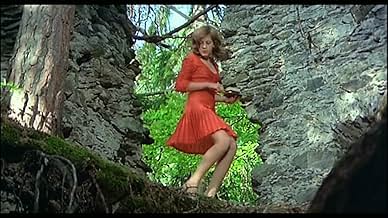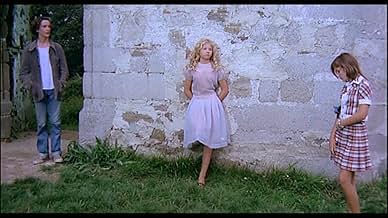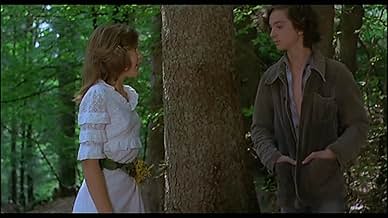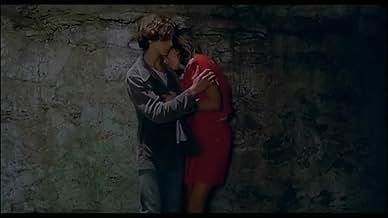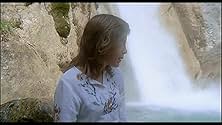NOTE IMDb
5,6/10
2,7 k
MA NOTE
En vacances à la montagne Fabrizio y retrouve Laura. Petit Roi des bois il s'essaie les griffes en tourmentant la fillette, et en la possédant à son gré (en tuant des oiseaux, aussi). Puis l... Tout lireEn vacances à la montagne Fabrizio y retrouve Laura. Petit Roi des bois il s'essaie les griffes en tourmentant la fillette, et en la possédant à son gré (en tuant des oiseaux, aussi). Puis la mortifie en lui imposant sa nouvelle élue : l'arrogante Silvia. [255]En vacances à la montagne Fabrizio y retrouve Laura. Petit Roi des bois il s'essaie les griffes en tourmentant la fillette, et en la possédant à son gré (en tuant des oiseaux, aussi). Puis la mortifie en lui imposant sa nouvelle élue : l'arrogante Silvia. [255]
- Réalisation
- Scénario
- Casting principal
Avis à la une
Normally depicting the kind of cruelty that children are capable of is limited to works of fantasy such as William Golding's Lord of the Flies. Maladolescenza, a German-Italian production from 1977, however, deals with it in a way that is powerfully real showing in graphic terms adolescent bullying and use of sex as an instrument of domination. Because of its depictions of children in sexual situations, however, it has been banned in many countries, most recently in Germany in 2006. While I'm not entirely clear about the purpose and intent of the director, I did not find it to be any more salacious than the films of Larry Clark and even more beautifully realized and honest. Please be advised, however, that Maladolescenza is a very disturbing film and is not recommended for those offended by cruelty to animals (in this case a bird) or children presented in the nude and in threatening situations.
Set to an original score by Pippo Caruso based on medieval songs and dances, the film takes place in a brooding forest that holds the ruins of an ancient city. There are only three actors in the film and they deliver memorable performances. Two adolescents, Fabrizio (Martin Loeb) and Laura (Lara Wendel), live close to the edge of the forest and spend their summer holidays playing together as they have for many years. 12-year old Laura is in love with Fabrizio and teases him sexually but he responds only by taunting and frightening her. Like most bullies, however, he knows just when to let up in order to reassure his victim and give her a false sense of security. When the two discover the mysterious old city, Fabrizio declares himself to be king, but in order for Laura to be queen, she must first be able to win the cruel tests he has devised.
Among these are having a snake thrown on top of you as you lay on the ground and being chased by a snarling dog through the woods. Laura, like many willing victims, proclaims her trust in Fabrizio in spite of his sadism and his killing of her pet bird. When they at last make love together, however, it is done with tenderness and the film shows Fabrizio as good hearted when it suits his own purposes. When a new 13-year old girl, Sylvia (Eva Ionesco), joins the group on the invitation of two friends, things do not work to Laura's advantage. Sylvia, unlike Laura, is manipulative and cold and soon she and Fabrizio join forces to humiliate and frighten Laura, at one time compelling her to run through the woods while they shoot bows and arrows at her while wearing terrifying masks.
Realizing that Fabrizio and Sylvia have fallen for each other, Laura heartbreakingly begins to dress and act like Sylvia to win back Fabrizio's affection but without success. As the summer nears an end, Fabrizio is determined that Sylvia will never leave him alone and the result is a senseless tragedy that could have been easily averted. Although the setting is idyllic, under the skillful direction of Pier Murgia, Maladolescenza maintains a constant atmosphere of impending threat. While the story can be seen as a metaphor for the confusing currents of puberty, it can also be interpreted as symbolic of the loss of innocence and the misdirection of sexual energy into avenues of power and domination, perhaps an underlying theme in the history of the Third Reich.
Set to an original score by Pippo Caruso based on medieval songs and dances, the film takes place in a brooding forest that holds the ruins of an ancient city. There are only three actors in the film and they deliver memorable performances. Two adolescents, Fabrizio (Martin Loeb) and Laura (Lara Wendel), live close to the edge of the forest and spend their summer holidays playing together as they have for many years. 12-year old Laura is in love with Fabrizio and teases him sexually but he responds only by taunting and frightening her. Like most bullies, however, he knows just when to let up in order to reassure his victim and give her a false sense of security. When the two discover the mysterious old city, Fabrizio declares himself to be king, but in order for Laura to be queen, she must first be able to win the cruel tests he has devised.
Among these are having a snake thrown on top of you as you lay on the ground and being chased by a snarling dog through the woods. Laura, like many willing victims, proclaims her trust in Fabrizio in spite of his sadism and his killing of her pet bird. When they at last make love together, however, it is done with tenderness and the film shows Fabrizio as good hearted when it suits his own purposes. When a new 13-year old girl, Sylvia (Eva Ionesco), joins the group on the invitation of two friends, things do not work to Laura's advantage. Sylvia, unlike Laura, is manipulative and cold and soon she and Fabrizio join forces to humiliate and frighten Laura, at one time compelling her to run through the woods while they shoot bows and arrows at her while wearing terrifying masks.
Realizing that Fabrizio and Sylvia have fallen for each other, Laura heartbreakingly begins to dress and act like Sylvia to win back Fabrizio's affection but without success. As the summer nears an end, Fabrizio is determined that Sylvia will never leave him alone and the result is a senseless tragedy that could have been easily averted. Although the setting is idyllic, under the skillful direction of Pier Murgia, Maladolescenza maintains a constant atmosphere of impending threat. While the story can be seen as a metaphor for the confusing currents of puberty, it can also be interpreted as symbolic of the loss of innocence and the misdirection of sexual energy into avenues of power and domination, perhaps an underlying theme in the history of the Third Reich.
The movie's fame makes people neglect its other contents. Questions about disturbing nudity mean closing eyes to avoid really disturbing questions and messages of the movie. Maladolescenza offers a dark, bleak, unpolished and sadly realistic picture of growing up, of the age that adults consider most beautiful years in whole life, either forgetting their youth, suppressing their memories the way people often do, or maybe indeed being so lucky to have a childhood of dreams.
And Maladolescenza is a dreamlike movie, a fairy tale that shows how easy can dreams become a nightmare, how close are fairy tales to horror. But it also confirms that never during whole human's life this extremes get so close as during school years.
Placing the movie in a inexpressibly beautiful nature is an ingenious decision. Such an ambient can hardly fail. "Mission", "Blue Lagoon", "Six Days Seven Nights", "Picnic at Hanging Rock"... but all these locations are rather exotic; Maladolescenza was filmed in the heart of Europe (though plot is carefully sited out of place and time) showing that beauty is all around if you just look for it. But it creates a contrast.
Apart from the first scene (a weird one, but a hint of Fabrizio's personality), the movie starts rather slowly, looking as a Saturday morning family movie. The idea to introduce only three characters appears to be effective - no one influences the kids, what makes the movie message even more disturbing: this shows what kids are, no one forces them to do what they do. Especially Fabrizio who lives in forest seems not to have much contact with rest of the world, his cruelty is immanent, essential. Sylvia is not much different, though she is a product of civilization: she not only joins Fabrizio's behaving, but induces more creative way of torture, gained in our modern "human" world. We can imagine her doing everything to be with most popular boy in the class, then with best sportsman in the school, later maybe with some pop-star...
Finally, Laura. The opposite character, played by Lara Wendel who came from nowhere. While Ionesco was already a famous photo model - her acting can be annoyingly stilted, but fits into Sylvia's character - and Loeb played main role in "Mes petites amoreuses", Lara is almost a newbie in movies as Laura is a newbie in teen-adulthood. But unlike Sylvia she is shy, obeys parent's orders (being home on time) and they trust her (letting her be away from home whole day). A perfect victim for bullying.
So this movie makes one of the best analyzes of bullying ever made on screen. A surprise for 70's, because the amount of this problem was recognized recently. Some movies dealt with bullying but hardly ever in such a pure form until Larry Clark's "Kids"; his "Bully", though using that word, deals with consequences of bullying in young adults (who still keep the same interpersonal relations). Only Scandinavians (who, at least in movies, understand children as if they had invented them) dare to handle it either as sub-plots or even main plots (Rubber Tarzan, Det skaldede spogelse, Saning eller konsekvens...). In other cinematographies victims of bullying are usually characters made to laugh at, as if they deserved their fate ("Back to Future" where Marty reverses the situation, what is unbelievable for real victim)..
Laura needs Fabrizio. She is lonely. This lonely forest is so uninhabited that she has no other peers. She grew up with Fabrizio and tolerates the changes he is going through. Believing it is only a passing period she accepts her role afraid she would be rejected otherwise. And here we see the difference between bullying and torturing or simple violence: Laura isn't running away or avoiding perpetrators (e.g. "Iluzija", "Bluebird", "Före stormen"), she constantly returns day after day hoping that things will become as they were before. But they never do. This obedience of the victim feeds bully's strength, his feeling of power grows.
Sexuality in the movie is not an expression of love (as some comments say) but it is also not a rape (as some others suggest). It is just the way victim is proving her loyalty and obedience.. In the beginning of the movie there is curiosity, peeking normal for the age, but once when bully-victim relation is established it affects the sexuality as well. Sylvia, who knows the real life better than Fabrizio and Laura, noticed or was told already that people (mostly females) can control others (mostly males) by proper use of sex. Fabrizio fell in trap, and Sylvia mixing the developing adolescent/adult sexuality and still existing child cruelty starts an avalanche that leads to tragedy.
For Laura this is not just one bad summer. Remember how she was happy to meet Fabrizio. She doesn't ever mention and never misses anything from outer world. Probably she hasn't good experiences there either, it's easy to assume she's been bullied in school too victims are special type of children and bullies will always recognize them. And now, the only safe and beautiful place became equal or even worse than her everyday world. The only true and gentle friend became equal or worse than the others. It's not hard to trace this fate to psychic disorders or suicides, so frequent in teenage years.
People who are easily offended, whose attitudes don't allow them to watch certain content, shouldn't give a try to this movie. But they still shouldn't blame it for being shallow, worthless, just because of things they've heard about it. The best way of checking is, certainly, watching, and it could be more useful for people who work with children (teachers, psychologists, social workers, counselors) and for victims of bullying, to understand why they couldn't help themselves... though a question why no one else didn't help (them) always stays unanswered.
And Maladolescenza is a dreamlike movie, a fairy tale that shows how easy can dreams become a nightmare, how close are fairy tales to horror. But it also confirms that never during whole human's life this extremes get so close as during school years.
Placing the movie in a inexpressibly beautiful nature is an ingenious decision. Such an ambient can hardly fail. "Mission", "Blue Lagoon", "Six Days Seven Nights", "Picnic at Hanging Rock"... but all these locations are rather exotic; Maladolescenza was filmed in the heart of Europe (though plot is carefully sited out of place and time) showing that beauty is all around if you just look for it. But it creates a contrast.
Apart from the first scene (a weird one, but a hint of Fabrizio's personality), the movie starts rather slowly, looking as a Saturday morning family movie. The idea to introduce only three characters appears to be effective - no one influences the kids, what makes the movie message even more disturbing: this shows what kids are, no one forces them to do what they do. Especially Fabrizio who lives in forest seems not to have much contact with rest of the world, his cruelty is immanent, essential. Sylvia is not much different, though she is a product of civilization: she not only joins Fabrizio's behaving, but induces more creative way of torture, gained in our modern "human" world. We can imagine her doing everything to be with most popular boy in the class, then with best sportsman in the school, later maybe with some pop-star...
Finally, Laura. The opposite character, played by Lara Wendel who came from nowhere. While Ionesco was already a famous photo model - her acting can be annoyingly stilted, but fits into Sylvia's character - and Loeb played main role in "Mes petites amoreuses", Lara is almost a newbie in movies as Laura is a newbie in teen-adulthood. But unlike Sylvia she is shy, obeys parent's orders (being home on time) and they trust her (letting her be away from home whole day). A perfect victim for bullying.
So this movie makes one of the best analyzes of bullying ever made on screen. A surprise for 70's, because the amount of this problem was recognized recently. Some movies dealt with bullying but hardly ever in such a pure form until Larry Clark's "Kids"; his "Bully", though using that word, deals with consequences of bullying in young adults (who still keep the same interpersonal relations). Only Scandinavians (who, at least in movies, understand children as if they had invented them) dare to handle it either as sub-plots or even main plots (Rubber Tarzan, Det skaldede spogelse, Saning eller konsekvens...). In other cinematographies victims of bullying are usually characters made to laugh at, as if they deserved their fate ("Back to Future" where Marty reverses the situation, what is unbelievable for real victim)..
Laura needs Fabrizio. She is lonely. This lonely forest is so uninhabited that she has no other peers. She grew up with Fabrizio and tolerates the changes he is going through. Believing it is only a passing period she accepts her role afraid she would be rejected otherwise. And here we see the difference between bullying and torturing or simple violence: Laura isn't running away or avoiding perpetrators (e.g. "Iluzija", "Bluebird", "Före stormen"), she constantly returns day after day hoping that things will become as they were before. But they never do. This obedience of the victim feeds bully's strength, his feeling of power grows.
Sexuality in the movie is not an expression of love (as some comments say) but it is also not a rape (as some others suggest). It is just the way victim is proving her loyalty and obedience.. In the beginning of the movie there is curiosity, peeking normal for the age, but once when bully-victim relation is established it affects the sexuality as well. Sylvia, who knows the real life better than Fabrizio and Laura, noticed or was told already that people (mostly females) can control others (mostly males) by proper use of sex. Fabrizio fell in trap, and Sylvia mixing the developing adolescent/adult sexuality and still existing child cruelty starts an avalanche that leads to tragedy.
For Laura this is not just one bad summer. Remember how she was happy to meet Fabrizio. She doesn't ever mention and never misses anything from outer world. Probably she hasn't good experiences there either, it's easy to assume she's been bullied in school too victims are special type of children and bullies will always recognize them. And now, the only safe and beautiful place became equal or even worse than her everyday world. The only true and gentle friend became equal or worse than the others. It's not hard to trace this fate to psychic disorders or suicides, so frequent in teenage years.
People who are easily offended, whose attitudes don't allow them to watch certain content, shouldn't give a try to this movie. But they still shouldn't blame it for being shallow, worthless, just because of things they've heard about it. The best way of checking is, certainly, watching, and it could be more useful for people who work with children (teachers, psychologists, social workers, counselors) and for victims of bullying, to understand why they couldn't help themselves... though a question why no one else didn't help (them) always stays unanswered.
This is one of the most banned movies or highly cut movies at all times, Cannibal Holocaust was banned in 33 countries, but when the time was right it became available all over the world. Maladolescenza never did. In 2002 there was a movie Ken Park that was discussed and been cut due the fact that adolescents were naked in the movie and Adam Chubbuck was in a controversial shot on the cover that was released. But the film wasn't banned because they were over 18 years old. Back in the seventies and especially at the end of that era everything could be done. The rise of the slashers, the glory days of (s)exploitation and the 42nd sleaze. But one thing people couldn't stand, the use or abuse of children. They still should be innocent. But some flicks dared the viewer to watch something different. In 1975 The Psychopath came out, a story about a looney children's television show host taking revenge when 'his kids' were punished from their parents, shown on screen. Beatings with a belt, what was normal in the seventies was shown. The movie never got a proper release. 1976 took it a bit further, Assault on Precinct 13 came out, a girl is shot in her face by an ice cream man. That scene had to been cut out, nowadays it's funny in some way, then it was a real shocker. 1989 brought us, Beware Children at Play. Children are killing adults but the adults take their revenge by killing the children. Never got a proper release and it was spit out by the journalists. But sometimes their was that special one, 1976, France brought us, Une Vraie Jeune Fille. Charlotte Alexandra played a 14 year old girl going on holiday on a farm with her uncle and aunt. Being bored she starts to exploit her body. One scene was much spoken about, she experiments with a worm running on her private parts. The movie was banned but is now available uncut. The age of Charlotte at the time being was never known, but she must have been around her twenties. The only thing known was that she was born at the end of the fifties. So she was an adult. One year later German/Italie brought us Maladolescenza. Again a story about a boy living in his own world and exploiting young girls to examen his/their bodies. Once it was known that it all was shown in an explicit way the movie became banned. There was nudity in it from the two girls, only 13 and 11 years old, showing their private parts and breasts. The only versions that were available was a cut version of 77 minutes, not the full 90 minutes. But the movie had a problem, showing young girls explicit it was an ideal movie for pedophiles. Well sought by them all copies were destroyed but of course some people had the full uncut versions. It was almost unavailable full uncut until in 2006 Andreas Bethmann brought out the full uncut on his X Rated Kult label as Spielen Wir Liebe only to be sold in Germany, of course that didn't work out and it was banned again. in some countries people went to jail just by buying this flick. There is a lot said about this flick, is it childpornography or not. Just let me tell that it was an official release, and the two girls were never forced to undress. But still, nowadays the word pedophile is a hot item and the movie is still banned. Even on ebay it is on the banned item list. Sometimes it pops up under Spielen Wir Liebe or Puppy Love. And guess what, it goes for a lot of money. So far no retailer dares to sell it. Probeply the most hard to get item on the net and at Conventions. All I want to say, if you can get a full uncut try to go back in those days were everything was possible. And still their will be voyeurs and pedo's searching for it, but it isn't that if you watch a horror you become a killer that if you watch this one that you will go hunting innocent children.
A typical 70s Italian coming of age film, original and good music, but with some quirks, interesting but not fantastic photography, poor and at times confused storyline (e.g. the role of the wolf-dog, and where does the boy come from?) with poor dialogue, nice ambiance.
The reason it is still (relatively) well-known and sought after is probably the nude scenes (including typical 70s pseudo-coitus) involving an 11 and 13 year old girl with an older teenage boy (Eva Ionesco and Laura Wendel) - it is interesting from a socio-political point of view to see how these representations of very young adolescents was considered acceptable and normal in the whole of Europe (and US) 30 years ago, whereas now it is more than taboo.
The story revolves round bullying of one girl (Laura) by the other two characters, and her discovery of sex, a quite accurate representation of an aspect teenage life. The character of Eva (Silvia) does not evolve to the very end of the film and already appears very versed in the erotic arts - there is no "coming of age" for her: she is a very vain young girl who is already aware of her sexual charms, but ultimately is just used and ends the film crying like the little girl she really still is. The boy is an utterly despicable bully, while Laura comes across as a very naive and weak victim.
The reason it is still (relatively) well-known and sought after is probably the nude scenes (including typical 70s pseudo-coitus) involving an 11 and 13 year old girl with an older teenage boy (Eva Ionesco and Laura Wendel) - it is interesting from a socio-political point of view to see how these representations of very young adolescents was considered acceptable and normal in the whole of Europe (and US) 30 years ago, whereas now it is more than taboo.
The story revolves round bullying of one girl (Laura) by the other two characters, and her discovery of sex, a quite accurate representation of an aspect teenage life. The character of Eva (Silvia) does not evolve to the very end of the film and already appears very versed in the erotic arts - there is no "coming of age" for her: she is a very vain young girl who is already aware of her sexual charms, but ultimately is just used and ends the film crying like the little girl she really still is. The boy is an utterly despicable bully, while Laura comes across as a very naive and weak victim.
Having grown up in Amsterdam,Holland, where our liberal ideas are pretty much the norm, I have to say that I cannot understand why this movie caused so many problems when it came out! Sure, it is a movie of the 70's when peace and love were still there amongst a lot of old and younger people in Holland. I saw the film on a good DVD version last year and thought it was a love story about youth, rite of passage and growing up. The music in the background was pretty dire and some of the scenes were a bit dull (what was the snake scene all about??) but generally it wasn't a bad film. If some people get wound up about preteen nudity, then all I can say is they should get a life!!
Le saviez-vous
- AnecdotesMaladolescenza has been banned in Germany since July 28, 2006. With consideration of German laws it is child-pornography (Paragraph 184 b StGB).
- Crédits fousA poem by Dezsö Kosztolányi, translated into Italian by Edith Bruck, is quoted in full before the end credits.
- Versions alternativesDue to the public outcry for the underage sex scenes, the film was cut down to 77 minutes when released in West German cinemas. Any scenes depicting child nudity was removed in that release.
Meilleurs choix
Connectez-vous pour évaluer et suivre la liste de favoris afin de recevoir des recommandations personnalisées
- How long is Maladolescenza?Alimenté par Alexa
Détails
- Durée
- 1h 34min(94 min)
- Mixage
- Rapport de forme
- 1.66 : 1
Contribuer à cette page
Suggérer une modification ou ajouter du contenu manquant

